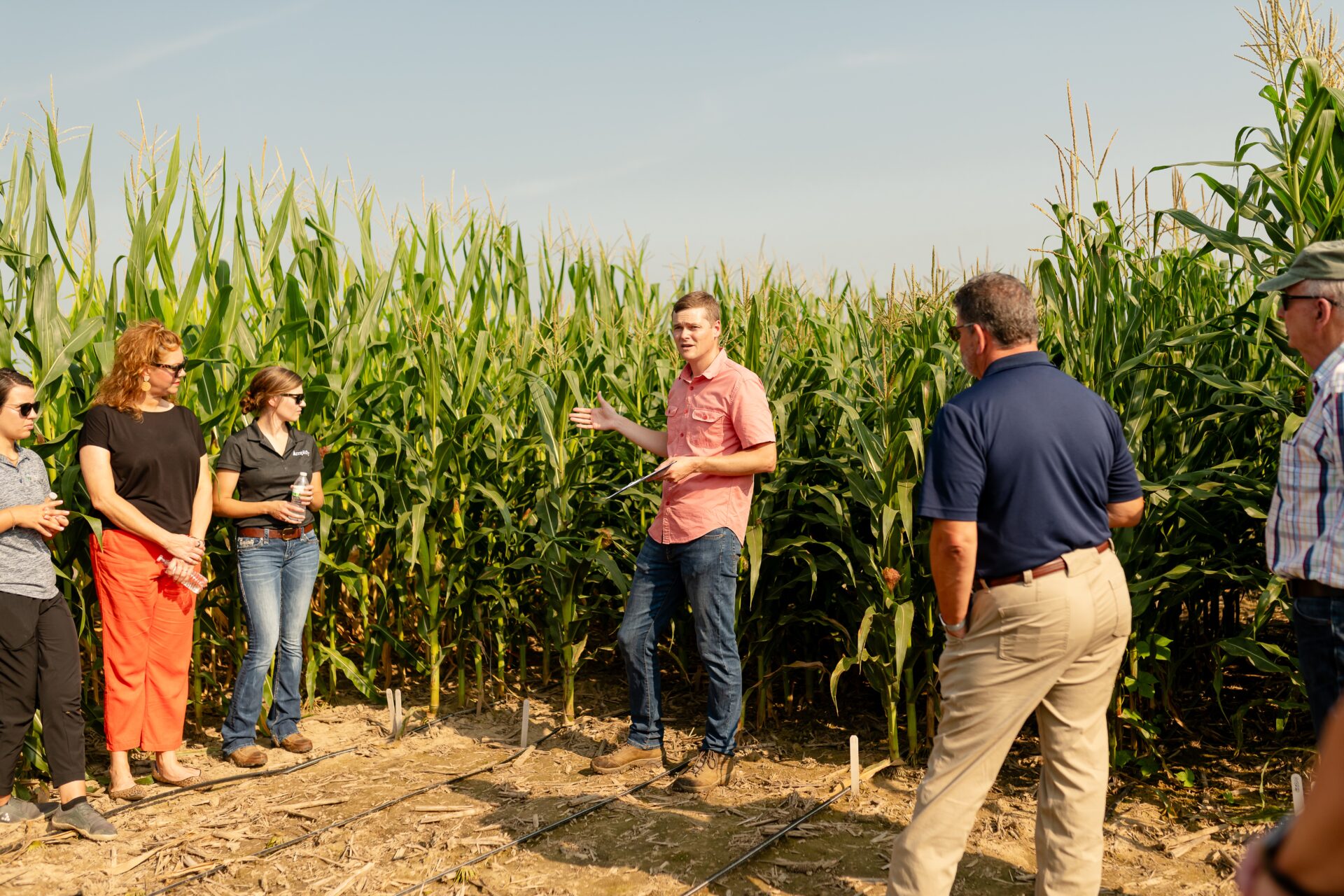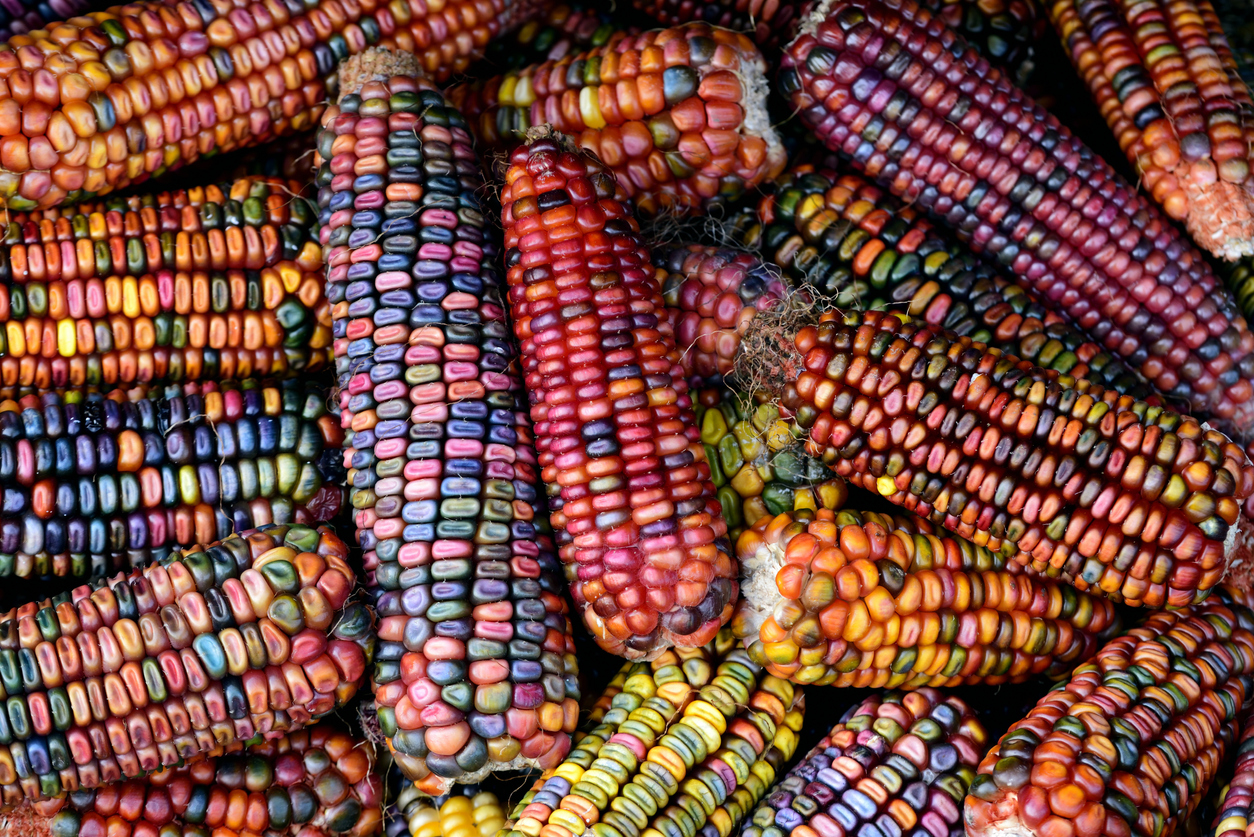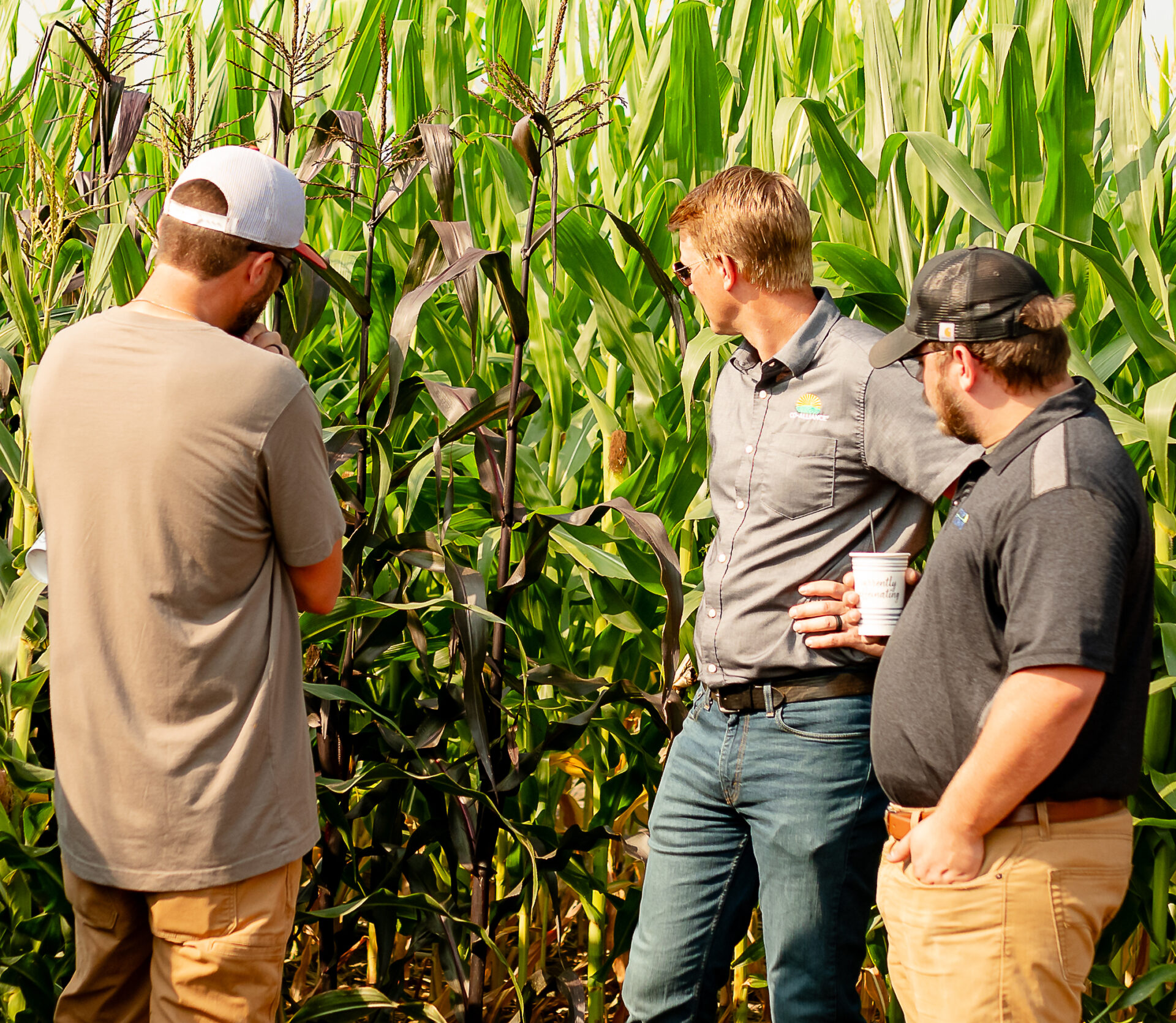“I’ve probably spent as much time in my life with my hand on the wheel of the tractor as I have on the science bench,” says Kyle Mohler, founder and CEO of US-based Insignum AgTech.
Mohler has channeled both his upbringing on a farm and his academic path in biotechnology into the company, which he founded in 2018 to help farmers better detect stress signals in crops.
“If a plant gets stressed, whether it’s by diseases or insects or low fertility, it’s already too late. You’ve already lost productivity,” he tells AgFunderNews. “Farmers have to be preventative in order to be effective at controlling these things.”
Insignum helps plants “talk” to farmers by using gene editing that turns on native pigments. When the plant detects stresses, it produces natural colors visible to the human eye and to cameras.
The Indiana-based company started with corn. When pathogens first infect the crop, the plant leaves turn purple, sending an early warning sign to the farmer who can then administer crop protection. If no disease or pathogen is present, the grower can leave off using that crop protection, potentially saving thousands in costs, not to mention the crop itself.
Insignum is entering its fourth year of field trials. In 2023, the company started collaborating with seed company Beck’s for the trials; it will continue that partnership in 2024. Most recently, Insignum got USDA approval to sell commercially in the US.
Below, Mohler goes into the history and the science behind his work.

AgFunderNews (AFN): What’s your background in terms of agriculture?
Mohler (KM): I was raised on a crop farm in central Indiana where we grew corn, soybeans, wheat and alfalfa hay. I was part of the 4-H [youth development] and FFA [Future Farmers of America] programs, as a lot of rural kids are.
I was particularly fascinated with the latest technologies coming out in agriculture when I was a kid, which in plants was the genetic technology. BT and Roundup Ready were the latest and greatest things, and that was really cool.
I studied biochemistry as an undergrad at Purdue and completed a couple of internships at Dow Agrosciences Sciences, which is near Purdue. That really opened my eyes to the potential of biotechnology in plants. I’m very thankful for those insights and the relationships I maintained from those days.
I’ve probably spent as much time in my life with my hand on the wheel of the tractor as I have holding a pipette on the science bench.
AFN: Why did you start Insignum?
KM: I was a postdoc at Purdue when I came up with the foundational concept. It was around that time I was also having conversations with my dad and brother. They had started to use fungicides [on the farm], whereas they hadn’t in the past.
I’m not exactly sure what the switch was that convinced my dad to start doing that. But the strategy was that they’d buy fungicides in the middle of winter and just spray every acre of both corn and soybeans every year.
I thought that that was crazy. Would you buy a product to solve a problem you don’t even have? Your seeds aren’t even in the ground.
It was through those conversations I learned that you have to be preventative in order to be effective at controlling for diseases, because you can’t heal plants in the same way you can heal animals.
If a plant gets stressed, whether it’s by diseases or insects or low fertility, it’s already too late. You’ve already lost productivity. So farmers have to be preventative in order to be effective at controlling these things.
That looks different in different types of crops. In row crops, most farmers won’t choose to spend the extra money on fungicides or insecticides or extra fertility because it’s a low-margin crop.
In the food crops, the calculus works a lot differently because they’re really high value and there’s a lot of money on the table. There’s also really strong pull from the supply chain. Whoever’s taking that crop has a lot of vested interest in making sure [the produce is] pristine and beautiful and that they don’t have a hint of disease or insect damage. Otherwise nobody will buy the crop.
Those farmers overspend a lot on fungicides and insecticides. For example, it’s not uncommon for our apples to be sprayed 20 times a year with pesticides. Farmers can’t afford for those trees or that fruit to get infected even just a little bit, because by the time it happens, it’s too late.
The fundamental problem is the same across crops, and that was the foundational problem that I started to ruminate on. So I put together a couple of different pieces of my academic knowledge to come up with Insignum Ag.
AFN: What does your technology do?
KM: We create genes that enable plants to use their pigments to talk.
What that means is that we’re trying to help farmers detect problems long before they would otherwise know about them.
Our first technology is in corn, and it makes the corn respond to disease.

AFN: How does it do that?
KM: All plants, including crop plants, have the ability to make a group of pigments called anthocyanins. They can produce, for example, different colors of corn on the same cob. Or apples that are yellow, green or red, or potatoes in different colors. Everything across the spectrum of food that we eat has the genes that can create these pigments.
But oftentimes, we’ve bred those genes to turn off so that we end up with just a green cabbage or orange carrot. The genes are all there, but they’re silent.
At Insignum, we use those genes as the output for our technology.
Using diseases as a specific example, when a spore lands on a leaf, the plant can within minutes recognize that and activate its defense system in order to turn off that pathogen. Some of that reaction is genetic in nature, so it turns on certain genes.
On the chromosome of DNA there are distinct genes. In between those genes is a region of DNA called the promotor that has to control the elements that tell that gene when, where, and if to turn on.
We find one of these genes that reacts to diseases and we use that promoter that turns on the gene in response to diseases to turn on the plant’s pigment gene. Both of those pieces are already present in the plant.
Our plants change color in the very early stages of a specific stress-like disease. Our platform can use multiple different colors — purple, red blue, etc. — to signal for multiple specific stresses — not only for diseases but for insect attacks or low fertility.
So farmers get the ability to optimize every acre or plant, get the plants exactly what they need when they need it, but only if they actually do need it.
It’s sustainable both economically and environmentally. We can eliminate those unnecessary applications that aren’t going to do any good but would have an environmental impact.
It’s sustainable for farmers because they can almost be guaranteed a return on the cost of that input before it gets applied.
From an agronomist perspective, you don’t just want to be spraying everything all the time. That’s gonna lead to resistance. One of the core tenets of agronomy is to put the right product in the right place at the right time. That’s exactly what we’re providing: the ability to not just preventatively spray everything — or on the flip side, ignore the problem and do nothing — but really treat crops based on those principles.
AFN: What challenges have you faced so far as an entrepreneur and a company?
KM: One of the things that has been the biggest problem for us is our timeline. Plants are just slow and it is incredibly difficult to use greenhouse or lab experiments to convince our customers that we have something real. Basically, they only care about field experiments. That means we get one chance a year.
But that doesn’t slow me down. I still love plants and plant agriculture and can see their potential to have such an influence on our world both on the human side and on the environmental side.
Another significant hurdle is fundraising. We’re not as well networked here in the Midwest as people on the coast, where [investors] are a lot more willing to take risks on early-stage startups.
I should say that I’m very fortunate to be working with a good set of investors. Here in Indiana, there is some ag tech but we have a lot of very strong healthcare and pharmaceutical tech because we have Eli Lilly and other pharmaceutical companies. We have the support of people from Elevate, and our angel investors have been really good.
The third group that has been really helpful is AG Ventures Alliance, which is a group out in Iowa. They have continued to invest in us and their farmer members invested their own money into us too.

AFN: What about regulatory concerns?
KM: In this space, it would be remiss if I didn’t talk about the regulatory side — that is a significant hurdle, and for good reason. People have a lot of concerns around any kind of genetic modification. These things need to be tested.
But there’s this tension between what is the real risk and what regulators could get sued for by an uneducated public.
For example, there, there was a new rule the USDA wrote a couple of years ago that said certain things can be exempt from regulation if they use a gene known to occur in that plant’s gene pool.
I thought, “We’re using a gene already found in corn and the corn’s gene pool, so we’re going to be exempt.” So we went to the USDA and said, “This is this is good, right?” They said no. We had to go back and we had to write a different kind of proposal. Just last week, we received our approval.
AFN: Where will you sell the product?
KM: We are now approved to go commercial in the US if we want to. But a lot of the supply chain doesn’t want us to because it’s really difficult to separate a particular crop so it doesn’t end up getting exported. So we’ll wait until we get our approval in other countries before we go commercial with a corn product.
I’m very thankful that the USDA at least has been very responsive and very helpful, and they got us through that process really quickly.
AFN: Any good lessons learned other startups should take note of?
KM: One of the things that I learned early is that I should have built my team faster. I was very fortunate to pull together a rockstar advisory board. To meet with those people on a regular basis has been extremely helpful for me and for the company.
I’m also very thankful that Purdue encouraged me to talk to my customers so quickly. That really changed the trajectory for us as a company to start testing things out in the field, sacrificing the lab and greenhouse studies.
I’ve been incredibly fortunate to have field space available to me because of the family farm, but even in the absence of that, I still think it’s super critical to get those field experiments and that field data very early on.
We started in the lab some, but we didn’t limit ourselves to the results we saw. Even though a low percentage of our varieties seemed to work in the lab, we just took all of our varieties out to the field, and we did see a lot of different results. We had a lot more success.
On the flip side, we had one variety that worked in the field that didn’t work in the lab. So if we hadn’t tested the entire breadth of our genetics out in the field, we would have missed some really important things.



